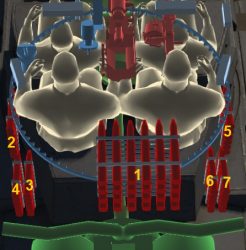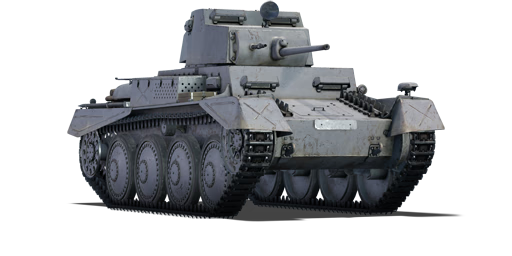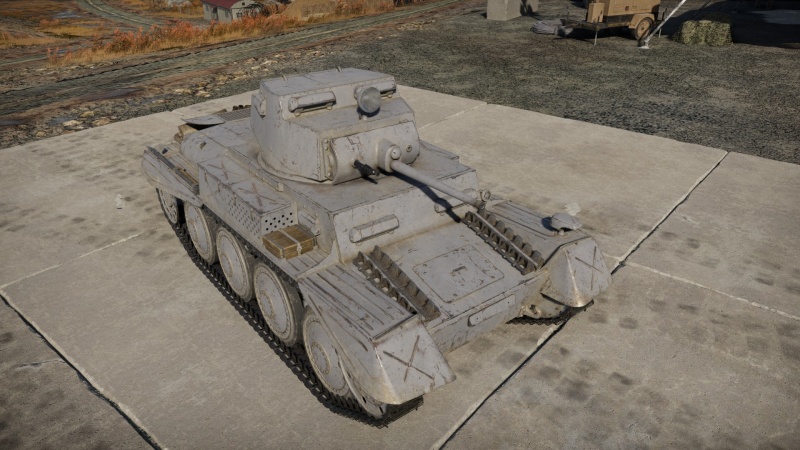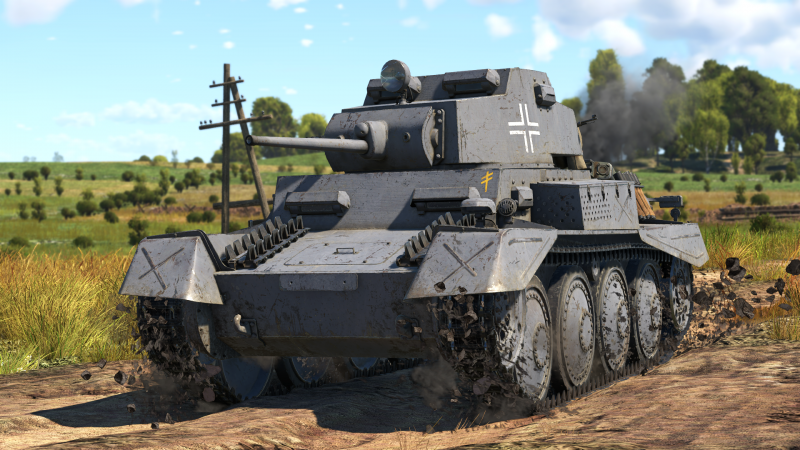Difference between revisions of "Pz.38(t) n.A."
m |
(→Description) |
||
| Line 13: | Line 13: | ||
== Description == | == Description == | ||
<!-- ''In the description, the first part should be about the history of the creation and combat usage of the vehicle, as well as its key features. In the second part, tell the reader about the ground vehicle in the game. Insert a screenshot of the vehicle, so that if the novice player does not remember the vehicle by name, he will immediately understand what kind of vehicle the article is talking about.'' --> | <!-- ''In the description, the first part should be about the history of the creation and combat usage of the vehicle, as well as its key features. In the second part, tell the reader about the ground vehicle in the game. Insert a screenshot of the vehicle, so that if the novice player does not remember the vehicle by name, he will immediately understand what kind of vehicle the article is talking about.'' --> | ||
| − | + | In September 1939, after the invasion of Poland, the Germans realised the obsolescence of their Panzer II and the need to replace it. Development of a new vehicle was undertaken by German companies MAN and Daimler-Benz, as well as the Czech ČKD (renamed as BMM), which had come under German control following the occupation of Czechoslovakia. BMM presented its tank, designated '''Pz.Kpfw.38(t) n.A.''' (''neuer Art'': "new type"), in December 1941. It was a substantial modification of the [[Pz.38(t) F|Pz.38(t)]], receiving a new, 220-horsepower engine, larger road wheels and wider tracks, an extended and largely redesigned hull, and a virtually completely reworked turret. Additionally, for the first time for BMM, the tank partially utilised welded armour. A total of 5 prototypes were built by April 1942, with minor differences between them: the initial vehicles lacked full-fledged optics and also used more riveted components. The vehicle ultimately lost out to the MAN design, known as the Luchs, but its running gear design was later used in the development of the [[Jagdpanzer 38(t)|Hetzer]]. One prototype survived the war and was used as a test laboratory. | |
| + | |||
| + | Introduced in [[Update "La Royale"]], the Pz.38(t) n.A. is represented by a late prototype with welded armour and optics. In battle, it is a fast and manoeuvrable tank with a good 37 mm gun, which also features a shoulder stabiliser that increases accuracy when firing on the move. However, its crew is positioned quite tightly in the hull, and the armour can only protect against autocannon fire. | ||
== General info == | == General info == | ||
| Line 19: | Line 21: | ||
{{Specs-Tank-Armour}} | {{Specs-Tank-Armour}} | ||
<!-- ''Describe armour protection. Note the most well protected and key weak areas. Appreciate the layout of modules as well as the number and location of crew members. Is the level of armour protection sufficient, is the placement of modules helpful for survival in combat? If necessary use a visual template to indicate the most secure and weak zones of the armour.'' --> | <!-- ''Describe armour protection. Note the most well protected and key weak areas. Appreciate the layout of modules as well as the number and location of crew members. Is the level of armour protection sufficient, is the placement of modules helpful for survival in combat? If necessary use a visual template to indicate the most secure and weak zones of the armour.'' --> | ||
| − | While armour isn't very favourable on the {{PAGENAME}} compared to the [[Pz.38(t) F]] at the same BR, it makes that in less weight and a better engine, allowing it to get into more favourable positions quicker; be it finding a good sniping/ambush spot or driving out an incoming shell. | + | While armour isn't very favourable on the {{PAGENAME}} compared to the [[Pz.38(t) F]] at the same BR, it makes that in less weight and a better engine, allowing it to get into more favourable positions quicker; be it finding a good sniping/ambush spot or driving out an incoming shell. |
'''Armour type:''' <!-- The types of armour present on the vehicle and their general locations --> | '''Armour type:''' <!-- The types of armour present on the vehicle and their general locations --> | ||
| Line 31: | Line 33: | ||
! Armour !! Front (Slope angle) !! Sides !! Rear !! Roof | ! Armour !! Front (Slope angle) !! Sides !! Rear !! Roof | ||
|- | |- | ||
| − | | Hull || 30 mm (20º) ''Front plate'' | + | | Hull || 30 mm (20º) ''Front plate'' |
| − | 20 mm (75º) ''Upper glacis'' 30 mm (15º) ''Lower glacis'' | + | 20 mm (75º) ''Upper glacis'' 30 mm (15º) ''Lower glacis'' |
| 25 mm || 20 mm (5º) || 10 - 20 mm | | 25 mm || 20 mm (5º) || 10 - 20 mm | ||
|- | |- | ||
Latest revision as of 16:33, 17 August 2024
| This page is about the German light tank Pz.38(t) n.A.. For other versions, see Pz.38(t) A and Pz.38(t) F. |
Contents
Description
In September 1939, after the invasion of Poland, the Germans realised the obsolescence of their Panzer II and the need to replace it. Development of a new vehicle was undertaken by German companies MAN and Daimler-Benz, as well as the Czech ČKD (renamed as BMM), which had come under German control following the occupation of Czechoslovakia. BMM presented its tank, designated Pz.Kpfw.38(t) n.A. (neuer Art: "new type"), in December 1941. It was a substantial modification of the Pz.38(t), receiving a new, 220-horsepower engine, larger road wheels and wider tracks, an extended and largely redesigned hull, and a virtually completely reworked turret. Additionally, for the first time for BMM, the tank partially utilised welded armour. A total of 5 prototypes were built by April 1942, with minor differences between them: the initial vehicles lacked full-fledged optics and also used more riveted components. The vehicle ultimately lost out to the MAN design, known as the Luchs, but its running gear design was later used in the development of the Hetzer. One prototype survived the war and was used as a test laboratory.
Introduced in Update "La Royale", the Pz.38(t) n.A. is represented by a late prototype with welded armour and optics. In battle, it is a fast and manoeuvrable tank with a good 37 mm gun, which also features a shoulder stabiliser that increases accuracy when firing on the move. However, its crew is positioned quite tightly in the hull, and the armour can only protect against autocannon fire.
General info
Survivability and armour
While armour isn't very favourable on the Pz.38(t) n.A. compared to the Pz.38(t) F at the same BR, it makes that in less weight and a better engine, allowing it to get into more favourable positions quicker; be it finding a good sniping/ambush spot or driving out an incoming shell.
Armour type:
- Rolled homogeneous armour
- Cast homogeneous armour (gun manlet)
| Armour | Front (Slope angle) | Sides | Rear | Roof |
|---|---|---|---|---|
| Hull | 30 mm (20º) Front plate
20 mm (75º) Upper glacis 30 mm (15º) Lower glacis |
25 mm | 20 mm (5º) | 10 - 20 mm |
| Turret | 30 mm (6º) Turret front 50 mm (5-38º) Gun mantlet |
12 - 25 mm | 20 mm (12º) | 12 mm (83º) |
| Cupola | 20 mm (25º) | 25 mm (9º) | 20 mm (23º) | 12 mm |
Notes:
- Two tracks on the upper glacis provide an additional 7.5 mm of protection.
Mobility
Write about the mobility of the ground vehicle. Estimate the specific power and manoeuvrability, as well as the maximum speed forwards and backwards.
| Game Mode | Max Speed (km/h) | Weight (tons) | Engine power (horsepower) | Power-to-weight ratio (hp/ton) | |||
|---|---|---|---|---|---|---|---|
| Forward | Reverse | Stock | Upgraded | Stock | Upgraded | ||
| Arcade | Expression error: Unexpected * operator. | 341 | Expression error: Unexpected round operator. | __.__ | |||
| Realistic | 195 | Expression error: Unexpected round operator. | __.__ | ||||
Modifications and economy
Armaments
Main armament
| 37 mm KwK38(t) | Turret rotation speed (°/s) | Reloading rate (seconds) | |||||||||||
|---|---|---|---|---|---|---|---|---|---|---|---|---|---|
| Mode | Capacity | Vertical | Horizontal | Stabilizer | Stock | Upgraded | Full | Expert | Aced | Stock | Full | Expert | Aced |
| Arcade | 60 | -10°/+25° | ±180° | Shoulder | 13.3 | 18.4 | 22.4 | 24.8 | 26.4 | 4.29 | 3.80 | 3.50 | 3.30 |
| Realistic | 8.3 | 9.8 | 11.9 | 13.2 | 14.0 | ||||||||
Ammunition
| Penetration statistics | |||||||
|---|---|---|---|---|---|---|---|
| Ammunition | Type of warhead |
Penetration @ 0° Angle of Attack (mm) | |||||
| 10 m | 100 m | 500 m | 1,000 m | 1,500 m | 2,000 m | ||
| Pzgr. 34(t) | APC | 62 | 59 | 45 | 32 | 23 | 17 |
| PzGr. 40 | APCR | 86 | 77 | 47 | 26 | 14 | 8 |
| Pzgr.(t) umg. | APC | 61 | 58 | 44 | 31 | 22 | 15 |
| Shell details | ||||||||||||
|---|---|---|---|---|---|---|---|---|---|---|---|---|
| Ammunition | Type of warhead |
Velocity (m/s) |
Projectile mass (kg) |
Fuse delay (m) |
Fuse sensitivity (mm) |
Explosive mass (TNT equivalent) (g) |
Ricochet | |||||
| 0% | 50% | 100% | ||||||||||
| Pzgr. 34(t) | APC | 741 | 0.85 | 1.2 | 9 | 22.1 | 48° | 63° | 71° | |||
| PzGr. 40 | APCR | 1,020 | 0.37 | - | - | - | 66° | 70° | 72° | |||
| Pzgr.(t) umg. | APC | 750 | 0.82 | 1.2 | 9 | 22.1 | 48° | 63° | 71° | |||
Ammo racks

| Full ammo |
1st rack empty |
2nd rack empty |
3rd rack empty |
4th rack empty |
5th rack empty |
6th rack empty |
7th rack empty |
Visual discrepancy |
|---|---|---|---|---|---|---|---|---|
| 60 | 37 (+23) | 31 (+29) | 25 (+35) | 19 (+41) | 13 (+47) | 7 (+53) | 1 (+59) | No |
Machine guns
The small calibre of the MG34 machine gun makes it largely ineffective against all armoured vehicles but the ones with an open compartment.
| 7.92 mm MG34 | ||||
|---|---|---|---|---|
| Mount | Capacity (Belt) | Fire rate | Vertical | Horizontal |
| Coaxial | 2,100 (150) | 900 | - | - |
Usage in battles
Describe the tactics of playing in the vehicle, the features of using vehicles in the team and advice on tactics. Refrain from creating a "guide" - do not impose a single point of view but instead give the reader food for thought. Describe the most dangerous enemies and give recommendations on fighting them. If necessary, note the specifics of the game in different modes (AB, RB, SB).
Pros and cons
Pros:
- Shoulder stabilizer
Cons:
- Somewhat weak gun at its BR
History
By 1942, action in Operation Barbarossa had seen the Pz.38(t) lose its capability as a regular tank, instead preforming reconnaissance missions, but production capacity for Pz.38(t) chassis still remained. As a solution Pz.38(t) n.A., which stood for Neuer Art, was a proposed modernized version of the Pz.38(t), but was rejected and Pz.38(t) chassis were instead used to build other vehicles such as the Marder III and Hetzer.
Devblog
Experimental light tank Pz.Kpfw.38 (t) n.A. was developed in 1941 by the Czech company BMM to participate in the reconnaissance tank contest for the German army. The tank was built on the chassis of the light Czechoslovak tank LT vz.38 and was distinguished by a more powerful gun, a new 8-cylinder engine, bigger wheels and wider tracks. Despite the best results in mobility trials, the tank was denied mass production due to high fuel consumption, a cramped turret and a 37 mm gun, which was considered excessive. Developments under the program Pz.Kpfw.38 (t) n.A. were further developed into light tank destroyer Jagdpanzer 38(t), also known as the Hetzer.
Media
- Skins
- Videos
See also
- Related development
External links
| Germany light tanks | |
|---|---|
| Pz.II | Pz.II C · Pz.II C (DAK) · Pz.II C TD · Pz.II F · Pz.Sfl.Ic |
| Sd.Kfz.234 | Sd.Kfz.234/1 · Sd.Kfz.234/2 · Sd.Kfz.234/2 TD |
| Marder | Marder A1- · Marder 1A3 · Begleitpanzer 57 · DF105 |
| SPz PUMA | PUMA · PUMA VJTF |
| Wheeled | Sd.Kfz.221 (s.Pz.B.41) · Class 3 (P) · Radkampfwagen 90 · Boxer MGS |
| Other | Ru 251 · SPz 12-3 LGS |
| Argentina | TAM · TAM 2C · TAM 2IP · JaPz.K A2 |
| Czechoslovakia | Pz.35(t) · Pz.38(t) A · Pz.38(t) F · Pz.38(t) n.A. · Sd.Kfz. 140/1 |
| France | Pz.Sp.Wg.P204(f) KwK |
| Lithuania | Vilkas |
| USA | leKPz M41 |
| USSR | SPz BMP-1 |






